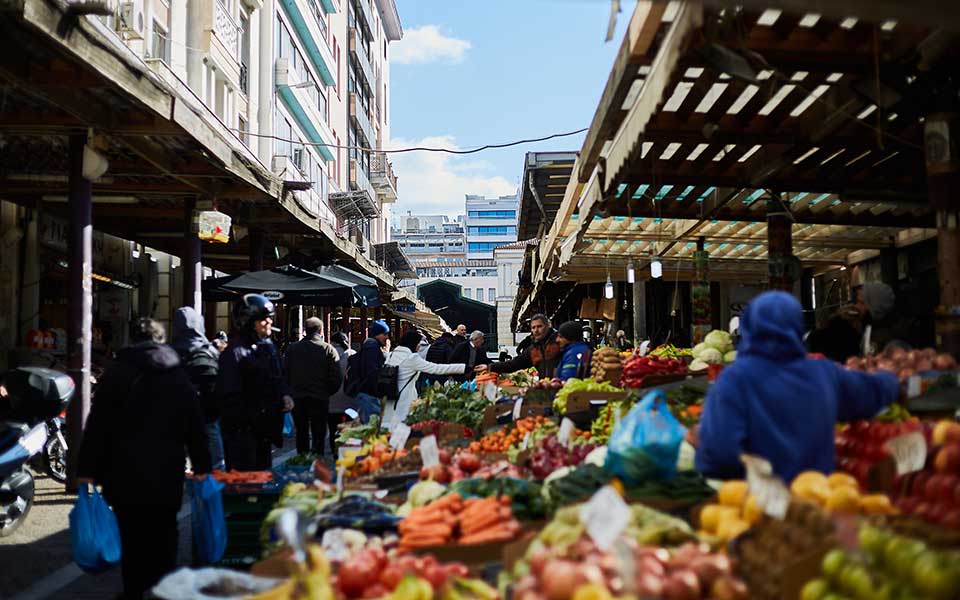The main part of the Varvakeios Market, the municipal market of Athens, is located inside one large structure laid out like a horseshoe, with left, right and rear corridors lined with meat and poultry sellers and a seafood market smack in the middle.
If you enter this central space from the east side of Athinas Street, you’ll walk straight into the net of the fishmongers; trying to get you to buy from their stalls, they’ll use compliments to reel you in; “With such beautiful eyes, it would be a shame not to get a little fish – fish are good for the eyes!”
Take care to walk slowly, as it’s slippery here. In total, there are 120 fishmongers, grouped together here at the core of the market – 2000sq.m. of fish! What’s more, every stall is numbered, so that people know, for instance, that number 68 belongs to Spyros Korakis.
The butchers’ stalls are located down each side of the paved corridors that surround the fish market, and these corridors are in fact streets – Aristogitonos Street, Armodiou Street and Filopimenos Street – which means each butcher operates from an actual street address.

© Dimitris Vlaikos
The market opens at 06:00, but these days the real work begins later. The deliveries from the slaughterhouses arrive after 07:30, and the Styrofoam boxes from the wholesale seafood market in Keratsini at 08:00-09:00.
The early morning customers have disappeared over the years, the result of the closing of the ksenichtadika, the tavernas that operated in the wee hours of the morning, after the bars and clubs had closed. “The traffic police set up a check point just outside the market, on Athinas Street, so those who’d had a bit too much to drink stopped coming here to eat,” one market worker explains.
Many decades ago, the market would open at midnight. The first customers were the managers of the fish restaurants, who would buy the finest of the first-rate fish available. Around 04:00, musicians coming from work at the bouzoukia (establishments with live bouzouki music) in the Tzitzifies area would begin to arrive. They’d have the money they earned that night, and would happily pay for a good fish dinner or perhaps a bowl of patsas, tripe soup, said to prevent hangovers, before heading home.
Today, only one of those tavernas remains – “Ipeiros,” next to the Aggelis butchers’ shop near the Aiolou Street entrance.

© Dimitris Vlaikos
“We have seventy butcher stalls in total, some old and some new,” says the market’s president, butcher Kleanthis Tsironis. “Evripiotis, Niotis, Koukiadakis and Pirlibos are some of the best ones and they all date back to those good years in the ’60s, when everyone came to shop here.”
Tsironis has worked here for fifty-five years; in fact he’s been coming here since he was a boy, just like most of the stall owners. “Everyone starts as a sweeper,” he explains, “then you learn to weigh the meat and to serve customers. It’s a long way to get to the knife, to debone, and finally to cut the meat.” Being the master butcher, the one who cuts, is a well-paying job, but few take up such work at the market these days, unless they’ve inherited a stall.
The career path at the fish stalls is perhaps slightly easier. Elli Leftheri, a third-generation fishmonger, worked as a graphic designer up until a few years ago. Today, she is respectfully continuing the work of her grandfather Ioannis Leftheris, famous here by the nickname Fondan, from the word “fondanakia”, meaning bonbons, as he was known to treat his customers to these while they were shopping. Their stall, number 64, specializes in frozen products, and carries a large selection ranging from king crab and smoked salmon to tuna, scallops and five-kilo octopuses.
At the front of the building, you’ll find shops and stalls selling spices, nuts, herbs, dried fruits, halva, essential oils, herbal teas, nut butters and non-dairy milks. A second part of the municipal market continues on the west side of Athinas Street, where Aristogitonos and Armodiou streets, now outdoors but still pedestrianized, both continue. Here you’ll find vegetable stalls and grocery stores.
This part of the market is less lively; many stalls have closed, and those that are open don’t follow the seasons in what they offer, like good stalls at most Athens farmers’ markets do.
The inventory of the grocery stores, meanwhile, seems to belong to another era entirely. You need a sharp eye to do your shopping in this part of the market, which could do with some serious improvement by those in charge so as to raise the standards on this side of the street, and place the whole of this historical market up where it truly belongs, among the best in Europe.
This article was first published in Greek by “Gastronomos” magazine.












